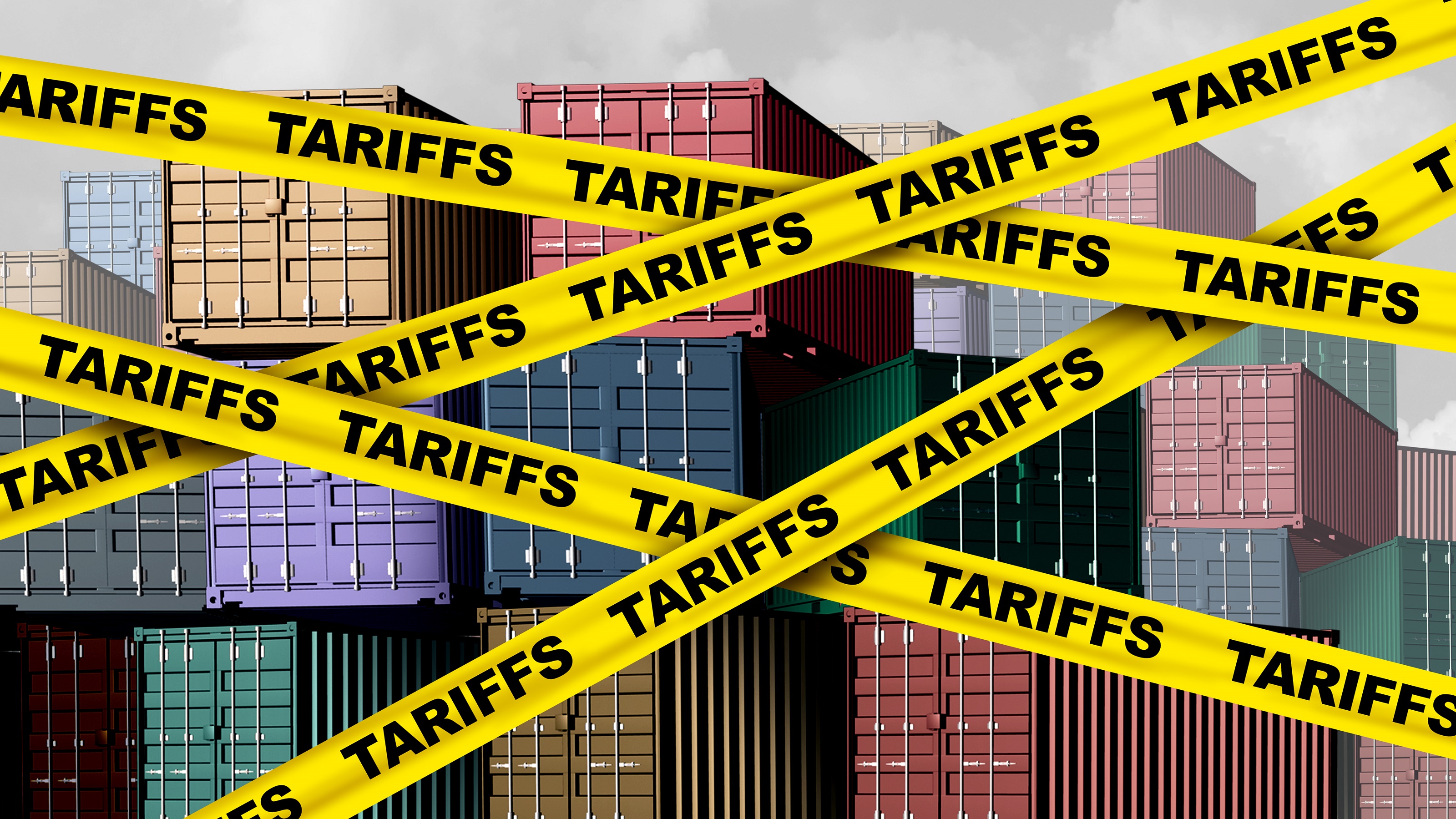Stagflation: What It Is and Why Retirees Should Care
The risk of stagflation is trending in the US due widespread tariffs, rising inflation and slower economic growth. Here's what it could mean to your retirement.


Forget inflation; stagflation is the back-to-the-future buzzword on Wall Street, and it could spell bad news for retirees.
While the U.S. economy isn’t officially in a period of stagflation yet, signs are pointing in that direction.
“Stagflation is basically higher inflation, combined with stagnant economic growth combined with increasing unemployment,” says Eric Diton, president and managing director of The Wealth Alliance. “Just looking at the current policy, it’s a legitimate risk.”

Sign up for Kiplinger’s Free E-Newsletters
Profit and prosper with the best of expert advice on investing, taxes, retirement, personal finance and more - straight to your e-mail.
Profit and prosper with the best of expert advice - straight to your e-mail.
Approaching a stagflation economy
There are several warning signs pointing toward a potential stagflation economy.
Take tariffs, for starters. President Trump unveiled sweeping tariffs on most of the world on April 2, announcing a 10% baseline tariff on goods coming into the country but for many countries including China, the European Union, Vietnam and Taiwan its much higher.
That move came as consumer confidence is already at a twelve-year low, small business sentiment is plummeting and inflation is inching back up with grocery prices — namely eggs and beef — on the rise.
Meanwhile unemployment is creeping up with continuing jobless claims, which tracks the number of people receiving unemployment benefits increasing to 1.9 million in the week ending March 22. The highest level since 2021, according to Bloomberg.
In March, layoffs increased 60% from February and 205% year-over-year, according to Challenger, Gray & Christmas, the global outplacement and business and executive coaching firm. The majority of the layoffs were from DOGE actions.
Government spending, which tends to inject growth into the economy, is a nonstarter as DOGE seeks to reduce what it calls fraud and waste from the federal government's coffers.
Meanwhile the stock markets are taking a beating, with the Dow Jones Industrial Average, Nasdaq and S&P all ending March in the red. Market volatility is rising as the Department of Government Efficiency or DOGE fires tens of thousands of government workers and creates policy uncertainty.
All of these conditions raise concerns the U.S. economy could be entering a period of stagflation.
“We’re already seeing indications (of stagflation) with rising inflation and increased market volatility. I think at this point a key unknown is how long is this going to last and how bad will it eventually get,” says David Blanchett, managing director, portfolio manager and head of retirement research for PGIM DC Solutions.
What stagflation means for retirees
Anyone who lived through the stagflation of the 1970s knows all too well what periods of high inflation and stagnate growth can mean for your pocketbook.
Prices for goods and services rise quickly, eroding consumers’ purchasing power. A sluggish economy could lead to increased layoffs and rising unemployment. For people already in retirement, it could mean a lot of belt-tightening is in the cards.
“Stagflation is a double whammy for retirees, who now have to pay for things (via inflation) and likely have lower savings if the markets continue to do poorly,” says Blanchett.
In periods of stagflation, it can be difficult for retirees to maintain their lifestyles without drawing more money from their retirement savings accounts. With the stock markets down, retirees can no longer absorb inflation with rising investment accounts as they did in the past, says Dann Ryan, managing partner at Sincerus Advisory.
Even when inflation hit a 40-year high in 2022, retirees had rising stocks to provide a cushion. That meant they could continue to spend at the same rate without worrying about paying more at the grocery store.
“In the past few years, retirees could meet inflation by taking on riskier assets like growth stocks or having higher equity exposures,” says Ryan. “Those opportunities might go away.” After all, stagflation could be bad for both stocks and bonds, he says.
As a result, Ryan says retirees may need to pay more attention to how much they draw down from their retirement accounts; they should make sure they are closer to the 4% withdrawal rate during periods of stagflation. Retirees may also need to rein in spending and change their lifestyle to handle an uptick in prices for goods and services.
If you are nearing retirement or on the cusp of exiting the workforce, you may want to reconsider that for now, especially if you can continue working. If you plan to work in retirement, Blanchett says to do something that can cover your bills without accessing your savings.
The longer you can wait to draw down from your retirement savings account, the better off you’ll be.
How you should approach your portfolio during stagflation
In periods of stagflation, the best way to control risk in your investment portfolio is to be as diversified as possible.
That means spreading your investments across several different assets. Diton says many of his clients' portfolios are either slightly positive or negative year-to-date but are not experiencing the declines seen in the S&P or Nasdaq — because they are well diversified.
“While parts of the markets are down, high dividend stocks like utilities are having a great year. International and emerging markets stocks are dramatically outperforming the S&P,” says Diton.
“If you are truly diversified in the right way and have assets that don't correlate with each other, you won’t experience anywhere near the volatility that the stock markets, especially the Magnificent Seven, are throwing at you right now.” The Magnificent Seven refers to Apple, Microsoft, Google's parent Alphabet, Amazon.com, Nvidia, Meta Platforms and Tesla.
For retirees concerned about inflation, Diton said Treasury Inflation-Protected Securities or TIPs, and short and intermediate-duration bonds are other areas to hide out.
The last thing you should do is panic. While stagflation is a real risk, financial advisers don’t think it will be as deep and prolonged as the stagflation seen in the 1970s.
“This too shall pass,” says Ryan. “I know it's scary. It’s going to dominate the headlines the first time we get a negative GDP number and upward inflation number, but it's important for retirees to know there are different flavors of stagflation.”
Related content
Get Kiplinger Today newsletter — free
Profit and prosper with the best of Kiplinger's advice on investing, taxes, retirement, personal finance and much more. Delivered daily. Enter your email in the box and click Sign Me Up.

Donna Fuscaldo is the retirement writer at Kiplinger.com. A writer and editor focused on retirement savings, planning, travel and lifestyle, Donna brings over two decades of experience working with publications including AARP, The Wall Street Journal, Forbes, Investopedia and HerMoney.
-
 Ten Cheapest Places To Live in Florida
Ten Cheapest Places To Live in FloridaProperty Tax Make your Florida vacation spot daily living — these counties have the lowest property tax bills in the state.
By Kate Schubel
-
 I'm 50 and my home is worth $5 million. Can I retire now?
I'm 50 and my home is worth $5 million. Can I retire now?It may be oh-so tempting to cash out your upscale home and leave work for good. But should you? We ask the experts.
By Maurie Backman
-
 I'm 50 and My Home Is Worth $5 Million. Can I Retire Now?
I'm 50 and My Home Is Worth $5 Million. Can I Retire Now?It may be oh-so tempting to cash out your upscale home and leave work for good. But should you? We ask the experts.
By Maurie Backman
-
 Bouncing Back: New Tunes for Millennials Trying to Make It
Bouncing Back: New Tunes for Millennials Trying to Make ItAdele's mournful melodies kick off this generation's financial playlist, but with the right plan, Millennials can finish strong.
By Alvina Lo
-
 Americans Are Retiring Later: Will This Trend Last?
Americans Are Retiring Later: Will This Trend Last?Given a host of pressures to keep working, Americans are retiring later in life. Will regulatory and economic forces encourage you to work longer?
By Christy Bieber
-
 Retiring Without a Partner? How Singles Can Maximize Their Savings
Retiring Without a Partner? How Singles Can Maximize Their SavingsRetirement can be expensive, especially when you do it alone, surveys show. But there are ways to maximize your retirement savings even when facing your second act without a partner.
By Kathryn Pomroy
-
 When Should You Hand Over the Keys — to Your Investments?
When Should You Hand Over the Keys — to Your Investments?The secret to retirement planning? "The best time to hand over the keys is before you’ve realized you need to hand over the keys."
By Maurie Backman
-
 Financial Steps After a Loved One's Alzheimer's Diagnosis
Financial Steps After a Loved One's Alzheimer's DiagnosisIt's important to move fast on legal safeguards, estate planning and more while your loved one still has the capacity to make decisions.
By Thomas C. West, CLU®, ChFC®, AIF®
-
 Two Don'ts and Four Dos During Trump's Trade War
Two Don'ts and Four Dos During Trump's Trade WarThe financial rules have changed now that tariffs have disrupted the markets and created economic uncertainty. What can you do? (And what shouldn't you do?)
By Maggie Kulyk, CRPC®, CSRIC™
-
 I'm Single, With No Kids: Why Do I Need an Estate Plan?
I'm Single, With No Kids: Why Do I Need an Estate Plan?Unless you have a plan in place, guess who might be making all the decisions about your prized possessions, or even your health care: a court.
By Cynthia Pruemm, Investment Adviser Representative